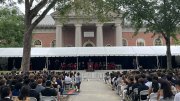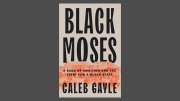Although the College has developed the roster of courses for the reenvisioned General Education portion of undergraduates’ curriculum, debuting this coming fall semester, a final piece of the puzzle remains. Alongside three divisional distribution courses and one course each in the curriculum’s four overarching themes (aesthetics and culture; ethics and civics; histories, societies, individuals; science and technology in society), students are supposed to complete a course in “empirical and mathematical reasoning” (EMR). When the Faculty of Arts and Sciences (FAS) debated the curriculum revision during the 2015-2016 academic year, it decided that a committee would define the requirement for students to learn how to reason with data, and also specify the mix of then-current Gen Ed courses, departmental options (from mathematics, statistics, or applied mathematics), or wholly new offerings that would fulfill this learning objective.
During the FAS meeting on April 2, dean of undergraduate education Amanda Claybaugh proposed to colleagues that EMR be reflagged and populated with existing courses. She moved that “the current requirement” in EMR become a “quantitative reasoning with data” (QRD) requirement, aimed at ensuring that Harvard undergraduates “reach a level of quantitative facility involving mathematical, statistical, and computational methods that will enable them to think critically about data as it is employed in fields of inquiry” across the FAS. Qualifying courses, as approved by the standing committee on general education, “may be offered in any FAS department, committee, or division,” but cannot displace the distribution requirement (a notion that had been bruited about in the past, at least for students who are concentrating in an obviously quantitative field).
In one sense, Claybaugh’s motion tidies up unfinished business: the Gen Ed curriculum is about to show up on students’ study-card choices in five months.
But the decision to use departmental and similar courses seemingly means that QRD instruction is, in effect, a fourth distributional requirement, rather than a new, fifth element in Gen Ed teaching and learning, per se. As the introduction to Gen Ed notes, “Gen Ed courses are unusually explicit in connecting the subjects you study to the people you will become and the world beyond the classroom. Transcending disciplinary divisions, they demonstrate the value of embedding what you will learn in your concentrations within the broader context of the liberal arts.”
Quantitative Reasoning and “Thinking with Data” in Perspective
Claybaugh has described the purpose-built, thematic courses as deliberately outside professors’ disciplinary teaching, with a recognizable, distinctive pedagogy and explicit connections to the wider world, with assignments that are outward-facing and perhaps even directly engaged with real-world challenges. Most departmental, committee, or divisional courses do not embed those design elements. A principal criticism of Gen Ed that led to the 2015-2016 reforms (and the thematic courses being introduced now) was precisely that after enactment of the 2007 legislation, hundreds of departmental courses were considered consistent with the curricular guidelines, even though they were not developed for that purpose and apparently failed, in many instances, to fulfill the program’s principles.
The 2015-2016 reform more or less split the difference in approaches: four course requirements in the thematic areas, all purpose-built for Gen Ed; three distribution courses (from departmental, disciplinary offerings); and the EMR, now QRD, course. Would moving from EMR—and the promise of purpose-built courses involving quantitative reasoning—to department courses mean that the faculty was cloning the experience after 2007 (when the Great Recession squeezed FAS’s finances and significantly affected the implementation of Gen Ed, prompting the dissatisfactions with the outcome expressed during the 2015-2016 debate and decision to revise the recently revised program)? Claybaugh was at pains to suggest not, or at least not entirely.
She reminded the faculty that the 2016 reforms led to a committee charged with devising new courses about “thinking with data,” a subject discussed within the Faculty Council and FAS as a whole. Among the issues were the rigor of the new courses, and a range of offerings appropriate for students at all levels of skill. In the fall of 2018, shortly after her appointment as dean, she continued, FAS dean Claudine Gay asked her to take a fresh look at the subject. She decided, she said (without specifying why), to set aside the new courses and to advance “a more modest proposal,” refocusing on “quantitative facility,” and established a committee of faculty members to advance that idea. Its chairs are Nina Zipser, a mathematics Ph.D. ’00, dean for faculty affairs and planning (and Lowell House co-faculty dean-designate), and David Cutler, Eckstein professor of applied economics, a health economist. Cutler, as reported here, taught one of the initial quantitative-reasoning courses introduced into the Core curriculum, and so has engaged directly with the challenge of melding data analysis with other kinds of content in his undergraduate teaching.
Cutler explained the committee’s work, focused on “operationalizing” quantitative reasoning with data as a course architecture. Such courses, the committee had determined, would:
- include quantitative approaches to analyzing data to, for example, make predictions or answer questions;
- involve different focal disciplines—such as statistics, mathematics, or algorithms—rather than insisting on a single focus, and would get at problems such as how sampling data affects inferences;
- apply those methods to real data (a nod toward the overarching Gen Ed aims), and not confine the instruction to just the methods; and
- require students to engage with the limitations of analytical methods and models.
Overall, Cutler said, the aim was to have students, in diverse kinds of courses, at differing levels of skill, complete a course in which they apply data to understand something about how the world works. Accommodating the demand will require 1,700 student course places per year; the committee has examined existing syllabi and talked with chairs, directors of undergraduate studies, and faculty members, and determined that some 1,500 such places certainly exist, and another 1,700 or so may qualify (perhaps with modifications of courses to include real-world problems or assignments). Faculty members, he said, were eager to have their courses qualify.
In the ensuing discussion, professors raised the intellectually central question, which figured in the Gen Ed debates in both 2007 and 2015: should the College require that students learn about quantitative reasoning per se (that is, mathematics, formal logic, and abstract reasoning), as an essential ingredient of a liberal-arts education; or was it content to teach about quantitative reasoning with data (the analytical techniques and skills or tools associated with statistics, survey research, and so on). The faculty has in effect been ambivalent about whether pure quantitative reasoning belongs in its undergraduate requirements—or whether it is more interested in assuring that students have exposure to a skill, the instrumental tool of reasoning with data, analogous to the required first-year expository-writing class.
[Updated April 8, 2019, at 9:00 a.m. to include the following extensive excerpts from a principal speaker during the debate.]
Cabot professor of the natural sciences Curtis T. McMullen, who is chair of mathematics, highlighted many of these issues and the FAS debates on Gen Ed during the past decade and more, noting:
Let my begin by saying that I fully recognize the intellectual value of engagement with data. My concern is not with what QR with data includes, but with what it excludes.
I would like to speak in favor of a requirement for quantitative reasoning per se, that would include the courses that engage with data identified by the QRD committee, but not be limited to them.
Here are some principles I have in mind.
- First, a liberal education should be about opportunities, not obligations.
- Second, students should take substantial responsibility for their educational choices.
Where do requirements come in? They come in to encourage students to explore new areas and challenge themselves.…They do not exist to fine-tune a choice of curriculum; this is done by the students themselves, together with a good advisor. Broadly framed requirements have lasting value and still give students autonomy.…
All courses in computer science, statistics, and mathematics, many courses in science, and courses that purposefully engage with data, would all qualify for a broad QR requirement. almost no math courses at Harvard will qualify for QR with data, and neither will many courses in CS and Stats.
The issue under discussion today is not new. I would like to recall two opinions expressed in the past that apply equally well to the case at hand.
First, speaking on “Thinking with Data” in 2017, Joseph professor of computer science and applied mathematics Salil Vadhan said:
“He did worry, however, that this topic was very much in the news and that fashioning a requirement that was very narrowly focused on this current point of attention might not be, in the long run, the course of action they would find most beneficial.”
The result was that the motion to endorse a requirement in “Thinking with Data” was withdrawn.
Second, the current EMR requirement was originally proposed as simply “Empirical Reasoning.” In 2007, Gade University Professor Barry Mazur urged that it be renamed “Empirical and Mathematical Reasoning,” saying:
"Without the addition o ‘and Mathematical’ to this subject area title, there is, in effect, no math in the proposed General Education program. The suggested change was an easy fix for this. Without this change, none of the eight subject categories allowed for courses that cultivated a level of mathematical literacy, mathematical sensibility, or for that matter, quantitative reasoning per se. He hoped that everyone in the committee of the whole realized how radical that would be and how it went counter to any prior view of what it meant to be educated.” (Minutes of the FAS meeting, May 8, 2007)
The motion passed with a show of hands.
For the same reasons, I suggest that Harvard adopt a broad, inclusive requirement in Quantitative Reasoning; a requirement that would affirm the value of basic science; a requirement that would leave Harvard’s educational program nimble enough to rapidly adapt to changing issues in science and society. [End of material added April 8, 9:00 a.m.]
Some speakers wondered what courses might qualify for the QRD proposal, since a list of those the committee has vetted and is considering was not provided for their consideration.
On the latter points, Claybaugh noted, the committee had not yet gained FAS approval for its proposal, so it could not spell out such details as if the QRD approach were already in effect. It hoped to determine whether its principles could, in fact, be satisfied, by seeing how they and potential QRD-qualified courses interact: the work it has been undertaking so far.
Moncher professor of physics and of astronomy Christopher Stubbs, who is FAS’s dean of science, favored the proposal. He thought students would benefit from both the proposed QRD course and education in abstract reasoning, logic, and mathematics. He had encountered students ill-prepared to analyze data, essential for furthering their research, and so thought the QRD requirement, as designed, was a useful component of their studies. Another professor said his own liberal-arts education had led him to study both techniques for working with data and mathematics.
Cutler said he and the committee hoped that QRD would be complementary to such studies—and would in fact encourage students with limited experience in quantitative work to get a taste for it, and to broaden their course choices during their undergraduate years. Based on its work to date, he continued, the committee had found that no department would be excluded from QRD-qualified courses: every field has instruction that seems appropriate for QRD approval.
The proposal, and presumably supporting information, will be before the faculty again, in May, for further consideration and a vote—in time, if approved, for implementation with the new Gen Ed requirements.
Into the Age of Data Science
devising QRD offerings from existing courses places them somewhat outside the Gen Ed roster—where qualifying classes must both fulfill the program’s broader civic purpose and incorporate its pedagogy: witness the language on “think[ing] critically about data as it is employed in fields of inquiry across the FAS,” rather than the tie to “the world beyond the classroom.” The QRD committee’s list of principles, delineated by Cutler, places the proposed QRD courses somewhere between Gen Ed’s distinctive courses and the departmental, distributional ones.
On a separate occasion, Claybaugh noted an important fact on the ground: students have stampeded into STEM concentrations (science, technology, engineering, and mathematics). “Here Come the Quants!” (January-February 2017) documented the phenomenon, which has only intensified. Teaching capacity in fields such as computer science, statistics, and applied math is at or beyond capacity, which may well have made it difficult, or impossible, to devise wholly new, potentially large-enrollment “thinking with data” courses for Gen Ed’s unveiling this fall. (Ironically, making it a requirement that all students take such a course atop the distribution criteria may increase demand to enroll in such classes. And for students already in a quantitative discipline, the now-inescapable QRD requirement further intensifies that element of their course of study, at the possible cost of an arts and humanities, social sciences, or sciences elective. But insisting upon a requirement for all does level the playing field among the STEM concentrators and, say, their arts and humanities student peers who may be reluctant to engage with explicitly quantitative course contents.)
When the 2015-2016 debate touched on “reasoning with data,” it pointed toward the emerging interest in data science, now the focus of a robust faculty initiative with a burgeoning research agenda and, presumably, educational aims. Institutions from Berkeley (with its new division of data science and information, aiming to engage the whole campus in computational and data-drive research and learning) to Yale (with its department of statistics and data science, and a half-dozen new undergraduate courses in data science) are encouraging new avenues toward discovery and learning. Harvard is, as well, but in a more roundabout way, as demonstrated by the proposal, presented today, on how it will move undergraduate learning, through Gen Ed, toward some sort of universal exposure to this way of thinking about, and in, the world.









